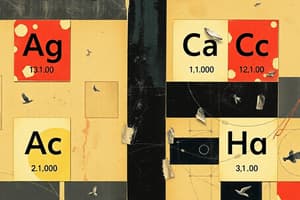Podcast
Questions and Answers
Explain the concept of chemical bonding and molecular structure as mentioned in the text above.
Explain the concept of chemical bonding and molecular structure as mentioned in the text above.
The concept of chemical bonding is the attractive force that binds atoms together in a molecule. It is formed either by the transfer of electrons or by the sharing of electrons. The text also discusses Lewis symbols, which represent the valence electrons in an atom, and how they are used to indicate the valency of an atom.
Define valence electrons and explain their role in the formation of a chemical bond.
Define valence electrons and explain their role in the formation of a chemical bond.
Valence electrons are the outermost electrons that participate in the formation of a chemical bond. They are responsible for the bonding of atoms either by transfer or sharing of electrons. The inner electrons, called core electrons, are well protected and do not participate in bonding.
How are chemical bonds formed in a molecule? Explain with examples.
How are chemical bonds formed in a molecule? Explain with examples.
Chemical bonds in a molecule are formed either by the transfer of electrons or by the sharing of electrons. For example, in the case of sodium [11Na -2,8,1], the chemical bond is formed by the transfer of one electron, while in the case of chlorine [17Cl -2,8,7], the bond is formed by the sharing of electrons.
Why are Lewis symbols considered informative? Provide examples to support your answer.
Why are Lewis symbols considered informative? Provide examples to support your answer.
What are Lewis symbols and how are they used to represent valence electrons?
What are Lewis symbols and how are they used to represent valence electrons?
Flashcards are hidden until you start studying




